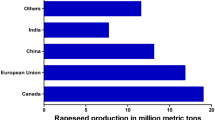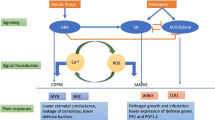Abstract
Hrip1 is a novel hypersensitive response-inducing protein secreted by Alternaria tenuissima that activates defense responses and systemic acquired resistance in tobacco. This study investigates the role that Hrip1 plays in responses to abiotic and biotic stress using transgenic Arabidopsis thaliana expressing the Hrip1 gene under the control of the stress-inducible rd29A promoter or constitutive cauliflower mosaic virus 35S promoter. Bioassays showed that inducible Hrip1 expression in rd29A∷Hrip1 transgenic lines had a significantly higher effect on plant height, silique length, plant dry weight, seed germination and root length under salt and drought stress compared to expression in 35S∷Hrip1 lines and wild type plants. The level of enhancement of resistance to Botrytis cinerea by the 35S∷Hrip1 lines was higher than in the rd29A∷Hrip1 lines. Moreover, stress-related gene expression in the transgenic Arabidopsis lines was significantly increased by 200 mM NaCl and 200 mM mannitol treatments, and defense genes in the jasmonic acid and ethylene signaling pathway were significantly up-regulated after Botrytis inoculation in the Hrip1 transgenic plants. Furthermore, the activity of some antioxidant enzymes, such as peroxidase and catalase increased after salt and drought stress and Botrytis infection. These results suggested that the Hrip1 protein contributes to abiotic and biotic resistance in transgenic Arabidopsis and may be used as a useful gene for resistance breeding in crops. Although the constitutive expression of Hrip1 is suitable for biotic resistance, inducible Hrip1 expression is more responsive for abiotic resistance.




Similar content being viewed by others
Abbreviations
- CaMV35S:
-
Cauliflower mosaic virus 35S promoter
- rd29A:
-
Promoter of desiccation-responsive rd29A gene in Arabidopsis thaliana
- POD:
-
Peroxidase
- CAT:
-
Catalase (Kong et al. 2011)
- dpi:
-
Days post inoculate
- hpi:
-
Hours post inoculate
- SA:
-
Salicylic acid
- JA/ET:
-
Jasmonates/ethylene
References
Atkinson NJ, Urwin PE (2012) The interaction of plant biotic and abiotic stresses: from genes to the field. J Exp Bot 63:3523–3543
Beissmann B, Beisener HJ (1990) Isolation and purity determination of a glycoprotein elicitor from wheat stem rust by medium-pressure liquid chromatography. J Chromatogr A 521:187–197
Chen MJ, Zeng HM, Qiu DW, Guo LH, Yang XF, Shi HX, Zhou TT, Zhao J (2012) Purification and characterization of a novel hypersensitive response-inducing elicitor from Magnaporthe oryzae that triggers defense response in rice. PLoS One 7:e37654
Clough SJ, Bent AF (1998) Floral dip: a simplified method for Agrobacterium: mediated transformation of Arabidopsis thaliana. Plant J 16:735–743
Das M, Chauhan H, Chhibbar A, Haq QMR, Khurana P (2011) High-efficiency transformation and selective tolerance against biotic and abiotic stress in mulberry, Morus indica cv. K2, by constitutive and inducible expression of tobacco osmotin. Transgenic Res 20:231–246
Ebel J (1998) Oligoglucoside elicitor-mediated activation of plant defense. BioEssays 20:569–576
Hogenhout SA, Van der Hoorn RAL, Terauchi R, Kamoun S (2009) Emerging concepts in effector biology of plant-associated organisms. Mol Plant Microbe Interact 22:115–122
Huang JG, Yang M, Liu P, Yang GD, Wu CA, Zheng CC (2009) GhDREB1 enhances abiotic stress tolerance, delays GA-mediated development and represses cytokinin signaling in transgenic Arabidopsis. Plant Cell Environ 32:1132–1145
Jefferson RA (1987) Assaying chimeric genes in plants: the GUS gene fusion system. Plant Mol Biol Rep 5:387–405
Kasuga M, Liu Q, Miura S, Yamaguchi-Shinozaki K, Shinozaki K (1999) Improving plant drought, salt and freezing tolerance by gene transfer of a single stress-inducible transcription factor. Nature Biotechnol 17:287–291
Keller H, Pamboukdjian N, Ponchet M, Poupet A, Delon R, Verrier JL, Roby D, Ricci P (1999) Pathogen-induced elicitin production in transgenic tobacco generates a hypersensitive response and nonspecific disease resistance. Plant Cell 11:223–235
Klarzynski O, Descamps V, Plesse B, Yvin JC, Kloareg B, Fritig B (2003) Sulfated fucan oligosaccharides elicit defense responses in tobacco and local and systemic resistance against tobacco mosaic virus. Mol Plant Microbe Interact 16:115–122
Kong XP, Pan JW, Zhang MY, Xing X, Zhou Y, Liu Y, Li DP, Li DP (2011) ZmMKK4, a novel group C mitogen-activated protein kinase kinase in maize (Zea mays), confers salt and cold tolerance in transgenic Arabidopsis. Plant Cell Environ 34:1291–1303
Kulye M, Liu H, Zhang YL, Zeng HM, Yang XF, Qiu DW (2012) Hrip1, a novel protein elicitor from necrotrophic fungus, Alternaria tenuissima, elicits cell death, expression of defence-related genes and systemic acquired resistance in tobacco. Plant Cell Environ 35:2104–2120
Kunkel BN, Brooks DM (2002) Cross talk between signaling pathways in pathogen defense. Curr Opin Plant Biol 5:325–331
Lin F, Ding HD, Wang JX, Zhang H, Zhang A, Zhang Y, Tan MP, Dong W, Jiang MY (2009) Positive feedback regulation of maize NADPH oxidase by mitogen-activated protein kinase cascade in abscisic acid signalling. J Exp Bot 60:3221–3238
Liu J, Zhu JK (1997) Proline accumulation and salt-stress induced gene expression in a salt-hypersensitive mutant of Arabidopsis. Plant Physiol 114:591–596
Ning J, Li X, Hicks LM, Xiong L (2010) A Raf-like MAPKKK gene DSM1 mediates drought resistance through reactive oxygen species scavenging in rice. Plant Physiol 152:876–890
Nürnberger T (1999) Signal perception in plant pathogen defense. Cell Mol Life Sci 55:167–182
Nürnberger T, Scheel D (2001) Signal transmission in the plant immune response. Trends Plant Sci 6:372–379
Peng JL, Bao ZL, Ren HY, Wang JS, Dong HS (2004) Expression of harpinXoo in transgenic tobacco induces pathogen defense in the absence of hypersensitive cell death. Phytopathology 94:1048–1055
Qiu DW, Mao JJ, Yang XF, Zeng HM (2009) Expression of an elicitor-encoding gene from Magnaporthe grisea enhances resistance against blast disease in transgenic rice. Plant Cell Rep 28:925–933
Shan DP, Huang JG, Yang YT, Guo YH, Wu CA, Yang GD, Gao Z, Zheng CC (2007) Cotton GhDREB1 increases plant tolerance to low temperature and is negatively regulated by gibberellic acid. New Phytol 176:70–81
Shao M, Wang J, Dean RA, Lin Y, Gao X, Hu S (2008) Expression of a harpin-encoding gene in rice confers durable nonspecific resistance to Magnaporthe grisea. Plant Biotechnol J 6:73–81
Takakura Y, Che FS, Ishida Y, Tsutsumi F, Kurotani K, Usami S, Isogai A, Imaseki H (2008) Expression of a bacterial flagellin gene triggers plant immune responses and confers disease resistance in transgenic rice plants. Mol Plant Pathol 9:525–529
Thatcher LF, Anderson JP, Singh KB (2005) Plant defence responses: what have we learnt from Arabidopsis? Funct Plant Biol 32:1–19
Zhang A, Jiang MY, Zhang JH, Tan MP, Hu XL (2006) Mitogen activated protein kinase is involved in abscisic acid-induced antioxidant defense and acts downstream of reactive oxygen species production in leaves of maize plants. Plant Physiol 141:475–487
Zhang YH, Yang XF, Liu Q, Zhang YL, Zeng HM, Yuan JJ, Mao JJ (2010) Purification of novel protein elicitor from Botrytis cinerea that induces disease resistance and drought tolerance in plants. Microbiol Res 165:142–151
Zhu F, Zhang P, Meng YF, Xu F, Zhang DW, Cheng J, Lin HH, Xi DH (2013) Alpha-momorcharin, a RIP produced by bitter melon, enhances defense response in tobacco plants against diverse plant viruses and shows antifungal activity in vitro. Planta 237:77–88
Zong XJ, Li DP, Gu LK, Li DQ, Liu LX, Hu XL (2009) Abscisic acid and hydrogen peroxide induce a novel maize group C MAP kinase gene, ZmMPK7, which is responsible for the removal of reactive oxygen species. Planta 229:485–495
Acknowledgments
We thank Dr. Jianping Yang (Institute of Crop Sciences, Chinese Academy of Agricultural Sciences, Beijing, China) for assistance with Arabidopsis planting. This work was supported by the National technology research and development program (863 program) project (Grant Nos. 2011AA10A205 and 2012AA101504), The State Key Laboratory for Biology of Plant Disease and Insect Pests, Institute of Plant protection, Chinese Academy of Agricultural science, No. 12 Zhong-guan-cun South Street, Beijing, China.
Author information
Authors and Affiliations
Corresponding authors
Electronic supplementary material
Below is the link to the electronic supplementary material.
11248_2014_9824_MOESM1_ESM.tif
Supplemental Fig. 1 Expression of Hrip1 in transgenic Arabidopsis a The transcript and expression levels of Hrip1 in the 35S∷Hrip1 and rd29A∷Hrip1 expression lines, as analyzed by PCR, RT-PCR, and western blotting. Total RNA and protein were extracted from WT plants and Hrip1-expressing plants grown under normal or salt conditions for 8 h. Different expression lines were analyzed by western blotting. All lines were analyzed using an unquantified concentration of protein extract. The protein is 17 kDa. b Representative leaves photographed at 8 dpi for GUS detection of rd29A∷Hrip1∷GUS and 35S∷Hrip1∷GUS transgenic plants and WT under control and stress conditions. The plants were grown on MS agar containing 25 µg mL−1 kanamycin and then exposed to salt for 8 h; GUS activity is shown in rosette plants (TIFF 2767 kb)
11248_2014_9824_MOESM2_ESM.tif
Supplemental Fig. 2 Germination of transgenic Arabidopsis on MS medium and MS supplemented with 75 mM NaCl and 50 mM mannitol. a Germination of seeds on medium at three days after stratification. b Germination rate of transgenic Arabidopsis under salt and drought stresses. The results are presented as the means and standard errors from three independent experiments; three lines of each construct were used. A total of 60 seeds of each line were used for each experiment (TIFF 4447 kb)
11248_2014_9824_MOESM3_ESM.tif
Supplemental Fig. 3 Relative root length of transgenic Arabidopsis. Phenotypes on MS medium supplemented with different concentrations of NaCl or mannitol. The relative root lengths were measured on day 7 after stratification (n = 90 for each condition), and photographs were taken. The results are presented as the means and standard errors from three independent experiments. * and **and *** indicate significant differences at P < 0.05 (TIFF 4276 kb)
11248_2014_9824_MOESM4_ESM.tif
Supplemental Fig. 4 Expression of stress tolerance-related genes in WT and Hrip1-expressing plants, as analyzed by qRT-PCR. Total RNA was extracted from 21-d-old plants grown under normal or stress treatment for 0, 1.5 h, and 10.5 h. Actin was used as an internal control. Each column represents an average of three replicates, and the error bars indicate the standard deviation. Different * indicate significant differences in comparison with WT at P < 0.05. a Expression of DREB2A and P5CS2 with 200 mM NaCl. b Expression of LOS6 and NCED3 with 200 mM mannitol. c Expression of PR1 and BGL2 with Botrytis. d Expression of PR4 and Thi2.1 with Botrytis (TIFF 9421 kb)
Rights and permissions
About this article
Cite this article
Peng, XC., Qiu, DW., Zeng, HM. et al. Inducible and constitutive expression of an elicitor gene Hrip1 from Alternaria tenuissima enhances stress tolerance in Arabidopsis . Transgenic Res 24, 135–145 (2015). https://doi.org/10.1007/s11248-014-9824-x
Received:
Accepted:
Published:
Issue Date:
DOI: https://doi.org/10.1007/s11248-014-9824-x




